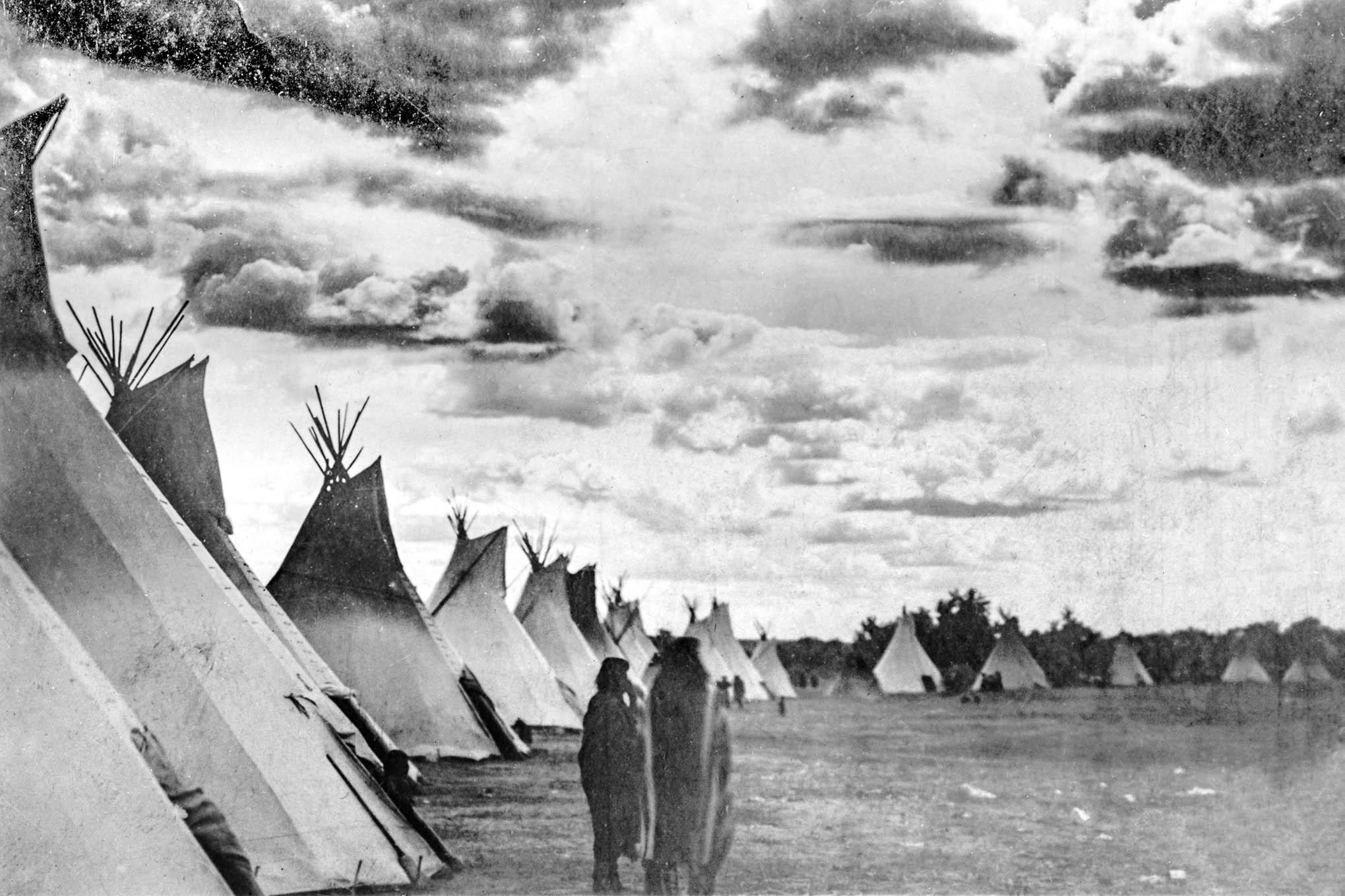
An undate image from the Umatilla Reservation.
Courtesy Oregon Historical Society Research Library, 008762
“We have been here since time began,” Don Ivy, chief of the Coquille Indian Tribe, said. “We have been here since the first human got here.”
For thousands of years, more than 60 tribes lived in Oregon's diverse environmental regions. At least 18 languages were spoken across hundreds of villages. Natural resources abounded.
“Before the non-Indians got here, we were some of the richest people in the world,” said Louie Pitt Jr., director of governmental affairs for the Confederated Tribes of the Warm Springs. “Oregon has been 100 percent Indian land.”
After thousands of years of history, life as the native people knew it was upended in just a few short decades.
For the new “Oregon Experience” documentary “Broken Treaties,” native Oregonians reflect on what has been lost since and what’s next for their tribes. The following quotes have been edited for clarity.
What Once Was
For most of history, Oregon wasn’t divided by lines on a map. It contained four distinct regions that varied in terrain, climate and resources. These variations shaped the way people lived. (The map below shows the cultural and language groups that existed prior to contact with settlers, and what the landscape of official reservations looks like today.)
"Each of their landscapes, each of their geographic areas dictated their traditions, dictated their technologies, decided their relationships with others. … Each of the tribes are defined by a particular place in the world."
Don Ivy
Chief, Coquille Indian Tribe
The Paiutes claimed most of what is now southeastern Oregon, part of the Great Basin. They lived for generations in the vast desert, walking long distances to hunt, gather and trade.

"I think the distinction was our ability to thrive and to live in country that other people found less desirable," says Charlotte Roderique, Former Tribal Council Chair, Burns Paiute Tribe.
OPB
The Northwest Coast region extended from Astoria to Gold Beach and encompassed the fertile Willamette Valley. The tribes of this region usually did not have to travel too far for food.
Most of northeastern Oregon — and a big swath down the center of the state — was plateau country. It’s a region of the state that’s wide and rolls in hills and valleys.
"The Cayuse, Umatilla and Walla Walla people were strong traders; they controlled much of the economic trade route that went into the Great Basin to our south, that went into southern Canada to our north."
Chuck Sams
Interim Deputy Executive Director, Confederated Tribes of the Umatilla Indian Reservation
Further south in Plateau country, the Warm Springs, Wascos, Klamaths, Modocs, Yahooskins and others thrived.
For centuries, these four cultural areas were home to Oregon’s first people. But when the Euro-Americans began settling in the area they saw something else.
"They tasted land and there was resources almost unbound … and Indian people were just in the way."
Louie Pitt Jr.
Director of Governmental Affairs, Confederated Tribes of Warm Springs
Pioneers often described Oregon’s diverse landscape as wilderness. They saw the forests, valleys and waterways as pristine and untouched. But the landscape had been maintained for millennia.
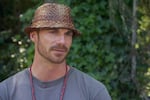
"Our ancestors would manage the land. … After finishing hunting elk, they would burn off that area, and they would do a couple of different things that would clean up all the underbrush and provide more feed for the elk and deer for the next year. And any woody material that was in the area (they) would burn it down, and then it would come back with nice straight shoots that would be usable for basket weaving."--Jesse Beers, Cultural Director, Confederated Tribes of Coos, Lower Umpqua And Siuslaw Indians.
OPB
The early European settlers who ventured west didn’t see such complexities in the land, or in the societies of people who tended it. In Oregon, the meeting of cultures was often violent, and it would lead a systemic upheaval of the state’s first people.
The “Discovery” Of The West
Some modern historians trace the pioneer mandate to settle the West can be traced back to 1493.
In the year after Christopher Columbus claimed the Americas for the Queen of Spain, Pope Alexander VI wrote the rules on the proper way to “discover” new land. His “Doctrine of Discovery” would guide Europe’s colonization of new territories around the world. And the ideas would echo in the occupation of land and subjugation of native people for hundreds of years.
“By the authority of God … We appoint you lords over them with full and free power, authority and jurisdiction of every kind.”
In 1806, Lewis and Clark's “Voyage of Discovery" asserted America’s presence in Indian country in the American West. And the U.S. Supreme Court later invoked the Doctrine of Discovery for the acquisition of that Indian land.
"The United States Constitution recognizes [tribes] as sovereign governments. But part of the Doctrine of Discovery claims the newly arrived United States or European country has an overriding sovereignty over the sovereignty of the indigenous groups, tribes, nations."
Robert J. Miller
Law Professor (Arizona State University), Tribal Judge and Author
In time, that policy would take on a new name: Manifest Destiny.

"Our inability to read and write, not living in permanent dwellings, not being an agricultural society — never mind that we were horticultural — are all things that were used to keep us labeled as ‘heathen, savages, primitives and uncivilized peoples.'"--Roberta "Bobbie" Conner, Director of Tamástslikt Cultural Institute Member Of The Confederated Tribes of the Umatilla Indian Reservation.
OPB
In the early 1830s, the Oregon Trail had established a direct route to the Pacific Northwest. The government encouraged Americans to make the journey and to settle there to strengthen its claim to the territory.
White settlers began to arrive in large numbers in the early 1840s.
"Initially, the contact was positive with some of the traders but then the folks that wanted our land — you know, moved in — and there was clashes and loss of life on both sides."
Don Gentry
Tribal Council Chairman, The Klamath Tribes
Before any treaties were signed — before the tribes had surrendered any of their land — the government began to officially give it away.
The Oregon Donation Land Act was passed in 1850, offering 320-acre parcels to thousands of white immigrants. In five years’ time, settlers would claim 2.8 million acres of Indian land.
The 1840s and '50s saw a sharp increase in violence between Indians and non-Indians.
In 1847, Cayuse warriors attacked the Whitman mission, blaming the Presbyterian missionaries for the measles that infected the tribe. They ended up killing thirteen people and burning down the mission. Clashes between soldiers, settlers and Indians grew more common place.
In 1855, several dozen miners came into a Coquille village, in what is now the town of Bandon, angry at an Indian man over a minor offense.
"They attacked them in the early morning while it was still dark. They burned all the houses and killed women and children. … They killed everybody."
Denni Hockema
Cultural Anthropologist For The Coquille Indian Tribe
For various reasons, white miners, ranchers and other settlers killed hundreds of native people. Sometimes it was with government approval.
But the most deadly force, with the most profound impact on tribal populations, would be epidemics.
Beginning in the late 18th century, outbreaks of introduced diseases swept through the territory. And in some areas, with no immunity to these new infections, more than 90 percent of the tribal people died. (The map below shows the relentless pace of those waves and how many of those diseases spread along the key transportation routes of the Willamette and Columbia rivers.)
[video: broken-treaties-disease,left,58c848b37505920012de9abd]
"There was so much decimation from pandemics, specifically measles, small pox, dysentery, influenza, typhus also takes their toll. But in particular — measles wiped out entire villages of Cayuse people."
Roberta "Bobbie" Conner
Director, Tamástslikt Cultural Institute Member Of The Confederated Tribes of the Umatilla Indian Reservation
Weakened by sickness and violence, most tribes knew they could not win a war with the U.S. Army. And the government knew that peaceful settlements were less costly than battle.
"Every time you killed one of their pony soldiers, they just reached into their vast numbers on the East Coast and replaced them … One of our warriors killed — it took many years to train another warrior up-and-coming to fill that place."
Chuck Sams
Interim Deputy Executive Director, Confederated Tribes Of The Umatilla Indian Reservation
Broken Treaties
In 1850, the first superintendent of Indian Affairs for the Oregon Territory, Anson Dart, set out to negotiate with the Indians. The mandate from the federal government was to get tribes to forfeit all their land claims west of the Cascades and move to reservations further east. The tribes would be compensated in various ways.
By the time Dart returned to Washington D.C., he had 19 signed treaties. In these documents, the tribes ceded about six million acres of their land to the government.
However, he failed to move the Indians out of western Oregon. Congress never ratified those treaties, and the president never signed them into law.
"What happened to the tribes quite often is that they thought they had a binding agreement. … They perhaps moved to the restricted area they had agreed too. And then money never came from the Congress because the treaty was not ratified."
Robert J. Miller
Law Professor (Lewis & Clark College), Tribal Judge and Author
Soon after the initial venture, the new superintendent for Indian Affairs, Joel Palmer, embarked on another round of treaty talks. But what exactly these talks looked like remains a mystery.
"The treaties weren’t negotiation. It was essentially Indian people being compelled to sign this with a promise that no harm will come your way. Don’t sign it and all bets are off."
Don Ivy
Chief, Coquille Indian Tribe
The Umatilla, Walla Walla and Cayuse Tribes negotiated a reservation on — or near — their ancestral lands. It was at the cost of ceding six million acres to the U.S. government. The 1855 treaty merged the tribes to become “The Confederated Tribes of the Umatilla Indian Reservation.”
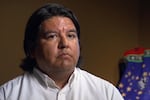
"They did so reserving our rights to all our usual and accustomed places so that we can hunt, fish, and gather — (it) is a critical part of that. They knew seven generations down the line that would be important to those children after them."--Chuck Sams, Interim Deputy Executive Director, The Confederated Tribes of the Umatilla Indian Reservation
OPB
The signers of the 1855 Walla Walla, Cayuse, and Umatilla Treaty agreed to certain boundaries for their reservation. But later, the government's survey would show half as much land. In the years that followed, the reservation got even smaller.
Eventually, a government policy turned their land into a patchwork of small allotments, privately owned by both Indians and non-Indians.
"[Settlers] went before their congressional delegation and got the support to reduce our land mass. By reducing our land mass down from a half a million acres to 157,000 acres, they were able to get access to that prime real estate for farming, and they were able to then build out the city of Pendleton."
Chuck Sams
Interim Deputy Executive Director, The Confederated Tribes of the Umatilla Indian Reservation
"The allotment era was not just a land grab. It was also a way to break down our communal structure and teach us to think: This is mine. That’s yours."
Roberta "Bobbie" Conner
Director, Tamástslikt Cultural Institute Member Of The Confederated Tribes of the Umatilla Indian Reservation
The treaty with the Warm Springs and Wasco tribes reserved their fishing and other rights by ceding an area one-sixth the size of the state of Oregon.
Tribes along the coast appear on a single document, which has come to be known as the “Coast Treaty.”
Superintendent Palmer traveled village to village, stopping to identify the local headmen. He would explain the terms of the treaty and acquire their marks, usually “X's.”
"Most people within most tribes spoke several languages because of the proximity of different tribes, but English wasn’t really one of them. So, it’s hard to say really as to what their understanding of the treaty was."
Jesse Beers
Cultural Director, Confederated Tribes of Coos, Lower Umpqua And Siuslaw Indians
The treaty specified a million-acre reservation where all these tribes would reside. It was a 105-mile strip along the western edge of the territory, to be called the “Siletz “ reservation — or the “Coast Reservation.”
In return for ceding most of their lands to the government, the Indians were promised a long list of compensations, including cash payments, sawmills, teachers — even arms and ammunition.
Soon after the treaty signings, the Indians were rounded up and led to the Coast Reservation, or the smaller, nearby Grand Ronde reservation.
"We refer to it as our trail of tears. … People were forced to swim with their kids on their backs across these rivers … all the way up the coast. … Those that came from more inland areas ... were forced to march up the coast. And of course in those days there were no bridges, no nothing, and they had to fend for themselves basically."
Bud Lane
Tribal Council Vice Chairman, Confederated Tribes of Siletz Indians
Other western Oregon tribes were marched along other routes to the Siletz or the smaller Grand Ronde reservations.
"It was in February. Imagine walking ... the rough path ran about where I-5 is today then out; once you get to Eugene, to where (Highway) 99 is. The whole way, people followed the Indians and essentially, if they were to break ranks and leave that line, they would be killed."
David Harrelson
Historic Preservation Officer, Confederated Tribes Of The Grand Ronde
Members of the coastal tribes — whose ancestors had lived in these places for countless generations — eventually learned the treaty had not been ratified. There would be no schools or blacksmiths, farm implements, nor return to their homelands.
Within ten years of its creation, the Siletz/Coast reservation began to be dismantled. By 1895, the once-immense coast reservation was gone. Today, the Siletz Reservation is less than 4,000 acres.

"We got nothing out of it but heartache."--Warren Brainard, Chief of Confederated Tribes of Coos, Lower Umpqua and Siuslaw Indians
OPB
The Future
Life took another dramatic turn for many tribes in 1954 when Congress passed Public Laws 587 and 588.
"We were all terminated. And termination was a government policy that ended the recognition of native people by the federal government."
David Harrelson
Historic Preservation Officer, Confederated Tribes Of The Grand Ronde
Virtually all the Indians west of the Cascades, plus the Klamaths, would no longer be "federally recognized." The laws were touted as an effort to liberate the native people from government oversight.
The terminated Indians saw their tribal holdings “repossessed” by the government. The Klamaths — who lost their vast timber holdings — received some financial compensation for their loss.
"Nowhere near the value of what the land was and people think it was like a willing seller-buyer relationship. It wasn’t."
Don Gentry
Tribal Council Chairman, The Klamath Tribes
Most U.S. tribes were not terminated, and elsewhere conditions for Indians were improving. As Congress approved new Indian health programs, new native education funding and various reservation housing projects for federally recognized tribes. But none of that translated to the terminated tribes of Oregon.
It would take anywhere between 20 to 30 years for most of the terminated tribes to be restored.
The people of each tribe had to convince Congress their members deserved to be re-recognized as Indians.
The Klamaths won their case on Aug. 26, 1986. By then, their million-acre reservation had been reduced to a few hundred. Nevertheless, restoration was a victory. They celebrate the anniversary in Chiloquin every year.
Three tribes in western Oregon established themselves as autonomous: the Cow Creek Band of Umpqua Tribe, the Confederated Coos, Lower Umpqua and Siuslaw and the Coquilles.
The larger confederations, the Siletz and the Grand Ronde, regrouped and looked to the future.
"We're the Grand Ronde Tribe. We're one unified entity and ... that is very strong in Grand Ronde because we all went through the common cause of termination and the effort to be restored as a people together."
David Harrelson
Historic Preservation Officer, Confederated Tribes Of The Grand Ronde
By the end of the 20th century, the native people of Oregon had survived deadly epidemics, vigilante raids and countless assaults on their culture.
But federal Indian policy was changing, and possibilities were opening up. Many tribes bumped up efforts to try to preserve their traditional languages. Though some had been lost forever.
Maintaining the Paiute language has become a priority for the Burns Paiute Tribe.
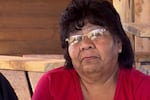
"I think we should instill some pride in our younger generation because they’re learning Spanish faster than they are learning their own native language. And it’s dying away. ...We’re losing it and it’s really important to gain that back as a people. This is who we are."--EstHer Sam, Language Project, Member Of The Burns (Fort McDermitt) Paiute Tribe
OPB
"It’s important to recognize that there are many artistic traditions in Oregon. … Along the Oregon Coast, you see a lot of open weave baskets. They’re beautiful and really intricately woven, very utilitarian for gathering clams and camas. And then when you get into the Columbia River region there’s a lot of stonework, a lot of carved material."
Deana Dartt
Former Curator, Native American Art, Portland Art Museum
The Warm Springs collection of art grew so big that the tribe built a museum to house it.
"The Indian cultures are still here, they are strong, they are getting stronger. … Most tribes, their population’s going up; their economy’s going up; they’re taking advantage sometimes of opportunities because of their sovereign status. Tribal gaming is an example of that."
Robert J. Miller
Law Professor (Lewis & Clark College), Tribal Judge and Author
The Cow Creek Band of Umpqua Tribe of Indians opened Oregon's first casino in 1994. Today all of Oregon’s nine federally recognized tribes have casinos.
"They’ve been able to build economies on the revenues that gaming generated — and they’ve got a place in the marketplace. … That gets you invited to the Chamber of Commerce banquet. … It gets you on boards and all of a sudden you begin to learn the rest of the world."
Don Ivy
Chief, Coquille Indian Tribe
The tribes are funding other work that may have far-reaching effects. Indians are increasingly playing active roles in resource management.
"This tribe fought to increase the water quality standards for the entire state in order to protect our fisheries and to protect our water. That benefit of exercising our treaty for that protection now benefits all Oregonians."
Louie Pitt Jr.
Director of Governmental Affairs, Confederated Tribes of Warm Springs
Dams and diversions blocked salmon migration in the Umatilla River for more than 70 years. By asserting their treaty right to fish the Umatillas were able to reroute a considerable amount of water. And today the Umatilla flows again.
In the Klamath Basin, battles over water have raged for decades. But a treaty provision has given the tribes a powerful seat at the bargaining table.
!["The courts determined that the Klamath Tribes had senior water rights throughout the former reservation and that caused a lot of contention of non-tribal members here that depended on it. … But the tribes [have] always been willing to share, and we’re sharing some of that water today."--Allen Foreman, Former Tribal Council Chair, The Klamath Tribes](https://opb-opb-prod.cdn.arcpublishing.com/resizer/v2/OCFM5GLCM5BGNFNZLFHOIOHIXA.jpg?auth=aeeaa987c7eefbaef010ef58a1a7f81c1445435986a8f791c1a78f0a1ca69d28&width=150)
"The courts determined that the Klamath Tribes had senior water rights throughout the former reservation and that caused a lot of contention of non-tribal members here that depended on it. … But the tribes [have] always been willing to share, and we’re sharing some of that water today."--Allen Foreman, Former Tribal Council Chair, The Klamath Tribes
OPB
These days, many Indians are well-versed in the details of those treaties of the 1850s and 60s. Most other Oregonians know little or nothing about them.
"How do people think that the state of Oregon got here? How did these counties get here? How did all of these cities get here? Under what legal authority? Under what basis do they exist?"
Bud Lane
Tribal Council Vice Chairman, Confederated Tribes of Siletz Indians
Looking to the future — as Oregon’s population grows and the climate changes — some of these individuals who've called this state home longer than anyone else has, believe they have a lot to offer.
"You've been — [for] ten thousand years — in one place and your culture and your genealogy is a part of that place. You have a better understanding of that place than anybody else. We have learned to live with it — we’re a part of it. The forest, the rivers, the coastline, the mountains — we are a part of all that. Our people are from there. And so everything we do in our culture resonates with that, and that’s important to say. I mean, not a lot of people except for us has that."
David Lewis
Independent Anthropologist and Historian, Confederated Tribes of the Grand Ronde
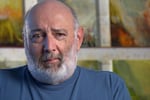
"This is a good place with good people, compassionate people, people who care about the land, people who care about one another. And that’s a good thing, you know — it’s a real good thing."--James Lavadour, Artist and member of the Confederated Tribes of the Umatilla Indian Reservation
OPB
"The bottom line is that native people, the people who are indigenous to these places, have an idea about how to steward, how to take care of these places. And all of us who are visitors to this place, ought to be listening to them, ought to be deferring to them, ought to be recognizing that the first people of this land know how to care for this land better than we do."
Deana Dartt
Former Curator, Native American Art, Portland Art Museum
Editor’s note: This article has been updated to show that Robert J. Miller is a law professor at Arizona State University. OPB regrets the error.